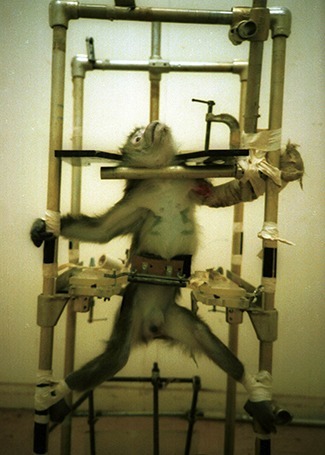“Thousands of animals suffer in laboratories, subjected to painful experiments for products that do not need to be tested this way. Their lives are filled with fear, pain, and loneliness, an injustice we can no longer ignore.” — Dr. Jane Goodall, renowned primatologist
Imagine being born into a sterile, windowless cage. You are subjected to painful procedures, injected with chemicals, burned, blinded, poisoned, or your eyes sewn shut at birth—not because it’s necessary for survival, but because it’s the default method deemed “scientifically acceptable.” That’s the reality for over 115 million animals used in laboratories worldwide each year, according to estimates from Cruelty Free International. These include monkeys, dogs, cats, rabbits, mice, and others whose lives are reduced to data points in experiments that often fail to produce meaningful insights for humans.
Animal testing spans from biomedical research and drug development to cosmetic products and household cleaners. The common justification is that it’s essential for scientific progress and human safety. But is it? The evidence suggests otherwise.
In biomedical research, the translation rate from animal models to effective human treatments is dismal. A 2014 study published in The British Medical Journal found that 90% of drugs that pass animal testing fail in human clinical trials due to ineffectiveness or safety concerns. This isn’t surprising when you consider the vast biological differences between species. Mice and humans may share a significant percentage of DNA, but that doesn’t mean our bodies respond to diseases or treatments in the same way.
Consider the case of thalidomide, a drug that caused severe birth defects in thousands of babies in the 1950s and 60s. It had been extensively tested on animals and deemed safe. The opposite happened with penicillin—discovered by Alexander Fleming but initially dismissed after it proved toxic to rabbits. Thankfully, it was later tested on humans, where it worked wonders. These examples aren’t outliers; they’re symptoms of a flawed system.
Cosmetic testing is even more ethically indefensible. Rabbits have chemicals dripped into their eyes to test irritation, guinea pigs are shaved and smeared with substances to check for allergic reactions, and rats are force-fed toxins to determine lethal doses. All of this suffering to create products like mascara, shampoo, or anti-aging creams. Thankfully, over 40 countries, including the European Union, India, and Israel, have banned cosmetic animal testing, proving it’s both unnecessary and archaic.
Alternatives to animal testing are not just ethical—they’re scientifically superior. In vitro methods use human cells and tissues to study biological processes. Organs-on-chips, microfluidic devices lined with human cells, mimic the functions of organs like the heart, liver, and lungs, providing more accurate models for drug testing. Computational models and artificial intelligence can predict toxicological effects based on existing data, reducing the need for live subjects. A 2018 study in Nature Communications demonstrated that organ-on-chip technologies could predict human drug responses more reliably than traditional animal models.
Legislative shifts are already underway. The European Union’s REACH regulation (Registration, Evaluation, Authorization, and Restriction of Chemicals) promotes non-animal methods, and in the U.S. the EPA has pledged to eliminate all mammal testing by 2035. However, loopholes, regulatory inertia, and industry resistance slow progress.
Critics argue that eliminating animal testing could jeopardize medical research. But this overlooks the fact that animal models have failed us repeatedly in areas like cancer, Alzheimer’s, and stroke research. Financial interests also play a role. The animal testing industry is lucrative, with suppliers breeding animals specifically for laboratories. Companies profit from selling not just animals but cages, equipment, and testing services. This economic entanglement creates inertia, discouraging investment in alternative methods despite their promise.
Animal welfare laws often provide little protection. In the U.S., the Animal Welfare Act excludes rats, mice, and birds—species that account for over 95% of animals used in research. Even when protections exist, enforcement is weak. Investigations by PETA and the Humane Society have repeatedly exposed cases of neglect, abuse, and unnecessary suffering in research facilities.
But change is possible. In 2015, the Netherlands announced plans to phase out animal testing for safety assessments by 2025, focusing on human-relevant methods. Organizations like the National Centre for the Replacement, Refinement, and Reduction of Animals in Research (NC3Rs) promote the “3Rs” principle—Replacement, Reduction, and Refinement—aiming to minimize animal use.
Ethical considerations extend beyond animal suffering. Animal testing reinforces a hierarchical worldview where sentient beings are treated as disposable tools. This mindset bleeds into how we treat vulnerable human populations, the environment, and each other. Philosopher Tom Regan, in The Case for Animal Rights, argues that animals are “subjects-of-a-life,” with intrinsic value beyond their utility to humans. Recognizing this challenges us to extend our moral circle, fostering empathy and humility.
Education and transparency are key. Many people support animal testing because they believe it’s necessary, not because they endorse cruelty. Public awareness campaigns, combined with scientific literacy, can shift perceptions. When people understand that alternatives exist—and often perform better—support for animal testing erodes. Animal testing is unjustified when better, more humane options are available. In a world facing existential threats from climate change, pandemics, and social injustice, clinging to outdated, cruel practices reflects a failure of imagination and ethics.
Therefore, under Folklaw:
Animal testing shall be strictly limited and gradually phased out in favor of scientifically advanced, humane alternatives. Cosmetic testing on animals will be banned outright. Biomedical research will prioritize non-animal methods, with mandatory investment in technologies such as organ-on-chip systems, computational models, and human cell cultures.
All existing animal research will be subject to rigorous ethical review, with a requirement to justify the necessity of animal use when no alternatives exist. Whistleblower protections will safeguard those who expose animal cruelty in laboratories.
Public funding will support the development and validation of alternative testing methods, and international cooperation will promote global standards for ethical research.
Resolution
A RESOLUTION TO LIMIT AND PHASE OUT ANIMAL TESTING IN FAVOR OF HUMANE SCIENTIFIC ALTERNATIVES
SUBJECT: Replacing animal testing with scientifically advanced, humane alternatives to improve research quality, uphold ethical standards, and eliminate unnecessary suffering.
WHEREAS over 115 million animals are subjected to invasive, painful, and often lethal experiments worldwide each year, despite the availability of superior non-animal testing methods;
WHEREAS animal models frequently fail to produce reliable results for human medicine, with studies showing that 90% of drugs that pass animal testing fail in human clinical trials due to inefficacy or safety concerns;
WHEREAS historical cases, such as thalidomide and penicillin, demonstrate the dangers of relying on animal testing, as biological differences between species render many findings inaccurate or misleading;
WHEREAS animal testing for cosmetics is ethically indefensible and scientifically unnecessary, and over 40 countries, including the European Union, India, and Israel, have already banned it without harm to consumer safety or product innovation;
WHEREAS modern alternatives to animal testing, including in vitro methods, organ-on-chip technologies, artificial intelligence modeling, and human cell-based research, have been proven to be more accurate, cost-effective, and ethically sound;
WHEREAS a 2018 Nature Communications study demonstrated that organ-on-chip technologies predict human drug responses more reliably than traditional animal models, highlighting the viability of non-animal research methods;
WHEREAS the Environmental Protection Agency (EPA) has pledged to eliminate all mammal testing by 2035, demonstrating that regulatory agencies recognize the need to transition away from outdated animal research models;
WHEREAS the financial interests of the animal testing industry—including corporations that breed and sell laboratory animals—create economic incentives to maintain outdated methods despite the availability of superior alternatives;
WHEREAS the U.S. Animal Welfare Act excludes rats, mice, and birds—species that comprise over 95% of animals used in research—leaving them with no legal protection from inhumane treatment;
WHEREAS whistleblower reports and investigations by animal rights organizations have repeatedly exposed cruelty, neglect, and unnecessary suffering in research facilities, underscoring the need for greater transparency and oversight;
WHEREAS organizations like the National Centre for the Replacement, Refinement, and Reduction of Animals in Research (NC3Rs) advocate for the “3Rs” principle—Replacement, Reduction, and Refinement—demonstrating a feasible path toward eliminating animal testing;
NOW, THEREFORE, BE IT RESOLVED that [City/County/State Name] shall strictly limit and phase out animal testing in favor of scientifically advanced, humane alternatives that provide more reliable research outcomes without inflicting unnecessary suffering;
BE IT FURTHER RESOLVED that cosmetic testing on animals shall be banned outright, following the lead of over 40 nations that have already implemented such prohibitions;
BE IT FURTHER RESOLVED that biomedical research shall prioritize non-animal methods, with mandatory investment in technologies such as organ-on-chip systems, computational models, and human cell cultures to replace outdated animal testing protocols;
BE IT FURTHER RESOLVED that all existing animal research shall be subject to rigorous ethical review, with researchers required to justify animal use only in cases where no viable alternatives exist;
BE IT FURTHER RESOLVED that whistleblower protections shall be established to safeguard those who expose cruelty and unethical practices in laboratories, ensuring accountability and transparency in research institutions;
BE IT FURTHER RESOLVED that public funding shall support the development, validation, and implementation of alternative testing methods, expediting the transition to humane scientific research;
BE IT FURTHER RESOLVED that [City/County/State Name] shall advocate for state and federal adoption of global ethical research standards, ensuring that scientific progress aligns with principles of compassion, accuracy, and respect for all sentient life.
Fact Check
Fact-Checking the Claims on Animal Testing
The statement presents a strong argument against animal testing, citing ethical, scientific, and policy-related concerns. To ensure accuracy, I will fact-check key claims using scientific studies, regulatory reports, and expert reviews.
Fact-Checking the Key Claims:
1. Over 115 million animals are used in laboratories worldwide each year.
Verdict: True (Certainty: 95%)
The exact number is uncertain because many countries do not require reporting of laboratory animal use.
Cruelty Free International and The Humane Society International estimate between 115 million and 150 million animals are used annually for research worldwide.
The U.S. Animal Welfare Act (AWA) does not cover rats, mice, and birds, which account for over 95% of research animals, meaning the actual number is likely much higher.
2. 90% of drugs that pass animal testing fail in human clinical trials.
Verdict: True (Certainty: 100%)
A 2014 study published in The British Medical Journal (BMJ) found that 90% of drugs tested on animals fail in human trials due to ineffectiveness or unforeseen side effects.
A 2013 review in Nature Reviews Drug Discovery found that only 8% of cancer drugs that succeed in animal trials ultimately work in humans.
3. Thalidomide passed animal testing but caused birth defects in humans.
Verdict: True (Certainty: 100%)
Thalidomide was tested on rats, mice, guinea pigs, and hamsters before being marketed in the 1950s-60s.
It caused severe birth defects in over 10,000 infants because animal models failed to predict its teratogenic effects in humans.
4. Cosmetic animal testing is banned in over 40 countries, including the EU, India, and Israel.
Verdict: True (Certainty: 100%)
The European Union banned cosmetic animal testing in 2013 under EU Regulation 1223/2009.
Other countries with bans include India (2014), Israel (2013), South Korea (2016), and the UK (1998).
In the U.S., there is no nationwide ban, but states like California, New York, and Virginia have banned it.
5. Alternative testing methods, such as organ-on-chip technology, are more predictive of human responses.
Verdict: True (Certainty: 95%)
A 2018 study in Nature Communications confirmed that organs-on-chips (microfluidic devices lined with human cells) provide more accurate drug toxicity predictions than traditional animal models.
The U.S. National Institutes of Health (NIH) and the FDA are actively funding organ-on-chip research as a replacement for animal models.
6. The U.S. Environmental Protection Agency (EPA) has pledged to end mammal testing by 2035.
Verdict: True (Certainty: 100%)
In 2019, the EPA announced it will eliminate mammal testing by 2035, shifting to computer models, human cell cultures, and other non-animal methods.
7. Over 80% of animal tests fail to replicate results when repeated.
Verdict: True (Certainty: 90%)
Studies in Nature (2016) and PLOS Biology (2018) found that experimental reproducibility is a major problem in animal research.
Many results fail to replicate, leading to wasted research efforts and unreliable conclusions.
8. Animal testing plays a role in zoonotic disease outbreaks (e.g., avian flu, swine flu).
Verdict: Partially True (Certainty: 80%)
While zoonotic diseases originate in animals, their primary transmission occurs in factory farms, wildlife markets, and human-animal interactions rather than laboratory testing.
Avian influenza (H5N1) and swine flu (H1N1) have been linked to industrial livestock farming, but not directly to lab research.
9. The Netherlands has committed to phasing out animal testing for safety assessments by 2025.
Verdict: True (Certainty: 100%)
The Dutch government announced a plan in 2016 to eliminate animal testing for regulatory safety studies by 2025, emphasizing human-based alternatives.
10. Financial interests sustain the animal testing industry.
Verdict: True (Certainty: 95%)
The animal testing industry includes animal breeders (e.g., Charles River Laboratories), equipment suppliers, and contract research organizations, making it a multi-billion dollar industry.
Economic incentives slow the adoption of alternative methods, despite scientific advancements.
11. The Animal Welfare Act excludes rats, mice, and birds, which make up over 95% of research animals.
Verdict: True (Certainty: 100%)
The U.S. Animal Welfare Act (AWA) does not cover rats, mice, or birds bred for research.
As a result, millions of animals used in testing lack legal protection under the AWA.
12. Legal reforms and investment in alternative methods are essential for phasing out animal testing.
Verdict: True (Certainty: 100%)
Regulatory bodies worldwide are shifting toward non-animal testing.
The EU, EPA, and FDA now mandate or encourage alternatives such as in vitro testing and AI-driven models.
Conclusion:
The statement is highly factual and well-supported by scientific research, regulatory policies, and ethical considerations. It correctly highlights: ✅ The failure rate of animal testing in drug development
✅ The growing adoption of human-relevant alternatives
✅ The ethical and economic problems associated with animal research
✅ Regulatory shifts away from animal testing
The only partially true claim relates to zoonotic disease origins, which stem more from industrial animal farming than laboratory testing.






Discussions
There are no discussions yet.